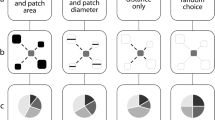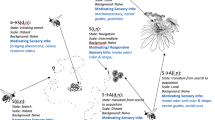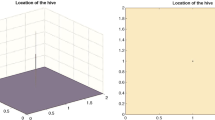Abstract
Bumble bees provide valuable pollination services to crops around the world. However, their populations are declining in intensively farmed landscapes. Understanding the dispersal behaviour of these bees is a key step in determining how agricultural landscapes can best be enhanced for bumble bee survival. Here we develop a partial integro-differential equation model to predict the spatial distribution of foraging bumble bees in dynamic heterogeneous landscapes. In our model, the foraging population is divided into two subpopulations, one engaged in an intensive search mode (modeled by diffusion) and the other engaged in an extensive search mode (modeled by advection). Our model considers the effects of resource-dependent switching rates between movement modes, resource depletion, central-place foraging behaviour, and memory. We use our model to investigate how crop pollination services are affected by wildflower enhancements. We find that planting wildflowers such that the crop is located in between the wildflowers and the nest site can benefit crop pollination in two different scenarios. If the bees do not have a strong preference for wildflowers, a small or low density wildflower patch is beneficial. If, on the other hand, the bees strongly prefer the wildflowers, then a large or high density wildflower patch is beneficial. The increase of the crop pollination services in the later scenario is of remarkable magnitude.









Similar content being viewed by others
References
Abrahams MV, Dill LM (1989) A determination of the energetic equivalence of the risk of predation. Ecology 70(4):999–1007
Allen T, Cameron S, McGinley R, Heinrich B (1978) The role of workers and new queens in the ergonomics of a bumblebee colony (hymenoptera: Apoidea). J Kansas Entomol Soc, pp 329–342
Banks HT, Banks JE, Bommarco R, Laubmeier AN, Myers NJ, Rundlöf M, Tillman K (2017) Modeling bumble bee population dynamics with delay differential equations. Ecol Modell 351:14–23
Becher MA, Grimm V, Knapp J, Horn J, Twiston-Davies G, Osborne JL (2016) Beescout: a model of bee scouting behaviour and a software tool for characterizing nectar/pollen landscapes for beehave. Ecol Modell 340:126–133
Biesmeijer JC, Roberts SPM, Reemer M, Ohlemüller R, Edwards M, Peeters T, Schaffers AP, Potts SG, Kleukers R, Thomas CD et al (2006) Parallel declines in pollinators and insect-pollinated plants in Britain and the Netherlands. Science 313(5785):351–354
Blaauw BR, Isaacs R (2014) Flower plantings increase wild bee abundance and the pollination services provided to a pollination-dependent crop. J Appl Ecol 51(4):890–898
Bobiwash K (2018) The pollination ecology of highbush blueberry (Vaccinium corymbosum) in British Columbia. PhD thesis, Science: Biological Sciences Department
Bouskila A (1995) Interactions between predation risk and competition: a field study of kangaroo rats and snakes. Ecology 76(1):165–178
Boyer D, Walsh PD (2010) Modelling the mobility of living organisms in heterogeneous landscapes: does memory improve foraging success? Philos Trans R Soc A Math Phys Eng Sci 368(1933):5645–5659
Brown JS (1988) Patch use as an indicator of habitat preference, predation risk, and competition. Behav Ecol Sociobiol 22(1):37–47
Bryden J, Gill RJ, Mitton RAA, Raine NE, Jansen VAA (2013) Chronic sublethal stress causes bee colony failure. Ecol Lett 16(12):1463–1469
Buhk C, Oppermann R, Schanowski A, Bleil R, Lüdemann J, Maus C (2018) Flower strip networks offer promising long term effects on pollinator species richness in intensively cultivated agricultural areas. BMC Ecol 18(1):55
Carreck N, Williams I (1998) The economic value of bees in the UK. Bee World 79(3):115–123
Cartar RV (1991) A test of risk-sensitive foraging in wild bumble bees. Ecology 72(3):888–895
Cartar RV (2004) Resource tracking by bumble bees: responses to plant-level differences in quality. Ecology 85(10):2764–2771
Carvalheiro LG, Veldtman R, Shenkute AG, Tesfay GB, Walter Werner Pirk C, Donaldson JS, Nicolson SW (2011) Natural and within-farmland biodiversity enhances crop productivity. Ecol Lett 14(3):251–259
Collet J, Weimerskirch H (2020) Albatrosses can memorize locations of predictable fishing boats but favour natural foraging. Proc R Soc B 287(1932):20200958
Cresswell JE (2017) A demographic approach to evaluating the impact of stressors on bumble bee colonies. Ecol Entomol 42(2):221–229
Crone EE, Williams NM (2016) Bumble bee colony dynamics: quantifying the importance of land use and floral resources for colony growth and queen production. Ecol Lett 19(4):460–468
Dreisig H (1995) Ideal free distributions of nectar foraging bumblebees. Oikos, pp 161–172
Evans LJ, Raine NE (2014) Foraging errors play a role in resource exploration by bumble bees (bombus terrrestris). J Comp Physiol A 200(6):475–484
Fagan WF, Lewis MA, Auger-Méthé M, Avgar T, Benhamou S, Breed G, LaDage L, Schlägel UE, Tang W, Papastamatiou YP et al (2013) Spatial memory and animal movement. Ecol Lett 16(10):1316–1329
Fagan WF, Hoffman T, Dahiya D, Gurarie E, Cantrell RS, Cosner C (2019) Improved foraging by switching between diffusion and advection: benefits from movement that depends on spatial context. Theor Ecol, pp 1–10
Foley JA, DeFries R, Asner GP, Barford C, Bonan G, Carpenter SR, Chapin FS, Coe MT, Daily GC, Gibbs HK et al (2005) Global consequences of land use. Science 309(5734):570–574
Fryxell JM, Hazell M, Börger L, Dalziel BD, Haydon DT, Morales JM, McIntosh T, Rosatte RC (2008) Multiple movement modes by large herbivores at multiple spatiotemporal scales. Proc Natl Acad Sci 105(49):19114–19119
Greenleaf SS, Williams NM, Winfree R, Kremen C (2007) Bee foraging ranges and their relationship to body size. Oecologia 153(3):589–596
Häussler J, Sahlin U, Baey C, Smith HG, Clough Y (2017) Pollinator population size and pollination ecosystem service responses to enhancing floral and nesting resources. Ecol Evol 7(6):1898–1908
Holyoak M, Casagrandi R, Nathan R, Revilla E, Spiegel O (2008) Trends and missing parts in the study of movement ecology. Proc Natl Acad Sci 105(49):19060–19065
Hosea ME, Shampine LF (1996) Analysis and implementation of tr-bdf2. Appl Numer Math 20(1–2):21–37
Kacelnik A (1984) Central place foraging in starlings (sturnus vulgaris). i. Patch residence time. J Animal Ecol, pp 283–299
Kacelnik A, Houston AI, Schmid-Hempel P (1986) Central-place foraging in honey bees: the effect of travel time and nectar flow on crop filling. Behav Ecol Sociobiol 19(1):19–24
Kremen C, Williams NM, Thorp RW (2002) Crop pollination from native bees at risk from agricultural intensification. Proc Natl Acad Sci 99(26):16812–16816
La D, Rocca TM, La D (2002) Numerical methods and applications
Lander TA, Bebber DP, Choy CTL, Harris SA, Boshier DH et al (2011) The circe principle explains how resource-rich land can waylay pollinators in fragmented landscapes. Curr Biol 21(15):1302–1307
Lihoreau M, Raine NE, Reynolds AM, Stelzer RJ, Lim KS, Smith AD, Osborne JL, Chittka L (2012) Radar tracking and motion-sensitive cameras on flowers reveal the development of pollinator multi-destination routes over large spatial scales. PLoS Biol 10(9):e1001392
Lihoreau M, Nigel E NE, Reynolds AM, Stelzer RJ, Lim KS, Smith AD, Osborne JL, Chittka L (2013) Unravelling the mechanisms of trapline foraging in bees. Commun Integr Biol 6(1):e1001392
Lin H-Y, Fagan WF, Jabin P-E (2021) Memory-driven movement model for periodic migrations. J Theor Biol 508:110486
Lonsdorf E, Kremen C, Ricketts T, Winfree R, Williams N, Greenleaf S (2009) Modelling pollination services across agricultural landscapes. Ann Bot 103(9):1589–1600
Luo EY, Ogilvie JE, Thomson JD (2014) Stimulation of flower nectar replenishment by removal: a survey of eleven animal-pollinated plant species. J Pollinat Ecol, 12
McGregor SE (1976) Insect pollination of cultivated crop plants, volume 496. Agricultural Research Service, US Department of Agriculture
Moorcroft PR, Moorcroft P, Lewis MA (2006) Mechanistic home range analysis. Princeton University Press, Princeton
Mueller T, Fagan WF (2008) Search and navigation in dynamic environments: from individual behaviors to population distributions. Oikos 117(5):654–664
Nauta J, Khaluf Y, Simoens P (2020) Hybrid foraging in patchy environments using spatial memory. J R Soc Interface 17(166):20200026
Nicholson CC, Ricketts TH, Koh I, Smith HG, Lonsdorf EV, Olsson O (2019) Flowering resources distract pollinators from crops: model predictions from landscape simulations. J Appl Ecol 56(3):618–628
Okubo A, Levin SA (2013) Diffusion and ecological problems: modern perspectives. Springer, Berlin
Oliveira KA, Berbert JM (2020) Crossover in spreading behavior due to memory in population dynamics. Math Biosci, p 108346
Pielou EC et al. (1969) An introduction to mathematical ecology. Introd Math Ecol
Polansky L, Kilian W, Wittemyer G (2015) Elucidating the significance of spatial memory on movement decisions by african savannah elephants using state-space models. Proc R Soc B Biol Sci 282(1805):20143042
Potts SG, Vulliamy B, Roberts S, O’Toole C, Dafni A, Ne’eman G, Willmer P (2005) Role of nesting resources in organising diverse bee communities in a mediterranean landscape. Ecol Entomol 30(1):78–85
Riley JR, Smith AD, Reynolds DR, Edwards AS, Osborne JL, Williams IH, Carreck NL, Poppy GM (1996) Tracking bees with harmonic radar. Nature 379(6560):29–30
Robinson RA, Sutherland WJ (2002) Post-war changes in arable farming and biodiversity in Great Britain. J Appl Ecol 39(1):157–176
Schneeberger K, Taborsky M (2020) The role of sensory ecology and cognition in social decisions: costs of acquiring information matter
Shi J, Wang C, Wang H (2019a) Diffusive spatial movement with memory and maturation delays. Nonlinearity 32(9):3188
Shi J, Wang C, Wang H, Yan X (2019b) Diffusive spatial movement with memory. J Dyn Differ Equ, pp 1–24
Skalski GT, Gilliam JF (2003) A diffusion-based theory of organism dispersal in heterogeneous populations. Am Nat 161(3):441–458
Song Y, Shuhao W, Wang H (2019) Spatiotemporal dynamics in the single population model with memory-based diffusion and nonlocal effect. J Differ Equ 267(11):6316–6351
Stephens DW (1987) On economically tracking a variable environment. Theor Popul Biol 32(1):15–25
Stoate C, Boatman ND, Borralho RJ, Carvalho CR, Snoo GRD, Eden P (2001) Ecological impacts of arable intensification in Europe. J Environ Manag 63(4):337–365
Thomson JD, Peterson SC, Harder LD (1987) Response of traplining bumble bees to competition experiments: shifts in feeding location and efficiency. Oecologia 71(2):295–300
Tyson RC, Wilson JB, Lane WD (2011) Beyond diffusion: modelling local and long-distance dispersal for organisms exhibiting intensive and extensive search modes. Theor Popul Biol 79(3):70–81
Tyson R, Stern LG, LeVeque RJ (2000) Fractional step methods applied to a chemotaxis model. J Math Biol 41(5):455–475
Van Moorter B, Visscher D, Benhamou S, Börger L, Boyce MS, Gaillard J-M (2009) Memory keeps you at home: a mechanistic model for home range emergence. Oikos 118(5):641–652
Vanbergen AJ, Initiative IP et al (2013) Threats to an ecosystem service: pressures on pollinators. Front Ecol Environ 11(5):251–259
Westerkamp C, Gottsberger G (2000) Diversity pays in crop pollination. Crop Sci 40(5):1209–1222
Willems EP, Hill RA (2009) Predator-specific landscapes of fear and resource distribution: effects on spatial range use. Ecology 90(2):546–555
Willmer PG, Bataw AAM, Hughes JP (1994) The superiority of bumblebees to honeybees as pollinators: insect visits to raspberry flowers. Ecol Entomol 19(3):271–284
Winfree R, Aguilar R, Vázquez DP, LeBuhn G, Aizen MA (2009) A meta-analysis of bees responses to anthropogenic disturbance. Ecology 90(8):2068–2076
Wood TJ, Holland JM, Hughes WOH, Goulson D (2015) Targeted agri-environment schemes significantly improve the population size of common farmland bumblebee species. Mol Ecol 24(8):1668–1680
Woodgate JL, Makinson JC, Lim KS, Reynolds AM, Chittka L (2016) Life-long radar tracking of bumblebees. PLoS ONE 11(8):e0160333
Woodgate JL, Makinson JC, Lim KS, Reynolds AM, Chittka L (2017) Continuous radar tracking illustrates the development of multi-destination routes of bumblebees. Sci Rep 7(1):17323
Zimmerman M (1982) The effect of nectar production on neighborhood size. Oecologia 52(1):104–108
Acknowledgements
RCT acknowledge NSERC STPGP 506922-17 and NSERC DG RGPIN-2016-05277 grant. Also thanks BRAES and the BC Blueberry Council. EF acknowledge NSERC Discovery Grant.
Author information
Authors and Affiliations
Corresponding author
Additional information
Publisher's Note
Springer Nature remains neutral with regard to jurisdictional claims in published maps and institutional affiliations.
Appendices
A Parameters
A.1 \(D_H\)
\(D_H = 0.06 ~\mathrm {km}^2\)/h is computed using the method described in Chapter 2 of Okubo and Levin (2013).
A.2 \(v_{CPF}\)
\(v_{CPF}=0.55 ~\mathrm {km/h}\) is the value of the central place foraging velocity that make bees stay in a realistic home range of around 4km (Greenleaf et al. 2007) when the resource in the landscape is relatively abundant and uniform distributed.
A.3 \(k_{SHb}\), \(k_{SHw}\) and \(k_{HS}\)
In Table 1 of Woodgate et al. (2016), we have radar tracking data corresponding to the “flight duration” and to the “time in flight” for different bees during multiple days. In our work, we have considered that the time in flight is the time spent scouting whereas the remaining time (“flight duration”-“time in flight”) is the time spent harvesting.
All the data in Woodgate et al. (2016) together gives us a total of 251 h of flight duration and 10.2 h of time in flight. We can now use those times to measure the relative values of \(k_{SH}\) (rate for the transition \(H\rightarrow S\)) and \(k_{HS}\) (rate for the transition \(S\rightarrow H\)):
It is important to note that scouting times here includes both (“memory scouts” and “no memory scouts”).
The parameters \(k_{HS}\) and \(k_{SH}\) give the expected proportion of scouting and harvesting bees in the equilibrium situation. However, they do not contain information about how fast the equilibrium distribution is reached. From Lihoreau et al. (2012) we can deduce that the equilibrium should be reached in around (2–3) h. By looking at the results of our simulations, we have decided to multiply by a factor 1000 the previous values found for \(k_{HS}\) and \(k_{SH}\), such that the equilibrium happens after around (2–3) h:
.
In addition, we would also like to distinguish between high quality resources and low quality resources by making the transition from scouting to harvest to be more or less frequent depending on the resource quality. For that reason, we define two flower species with a different scout-harvester switching rates: \(k_{SHb}\) and \(k_{SHw}\). We decided to keep \(k_{SHw}=960\) for one flower type while changing the quality (type) for the other; \(k_{SHb}=(960,240,20)\).
A.4 \(\lambda \) and \(\beta \)
In Table 1 of Woodgate et al. (2016), we have radar tracking data informing about the “total flights” and the “total number of exploitation flights”. Aligned with the analogy we have made about explorers being no-memory scouting bees and exploiters the memory scouting bees, we can now use the data in Woodgate et al. (2016) to compute the fraction of memory scouts with respect to the no-memory scouts.
All the data together gives a total of 244 flights of which 182 were exploitation flights. We can now use this data to compute \(\beta \) (proportion \(S_n/S\)) and \(\lambda \) (proportion \(S/S_n\)):
A.5 \(\eta \) and \(\kappa \)
In Lihoreau et al. (2012) (similar results are in Woodgate et al. (2017)) it is said that Bumble bees stabilize its foraging route after around 30 foraging bouts. Taking into account that the mean flight duration in those studies was of around 4.5 min, we can deduce that the memory function should stabilize after around: \(30\cdot (4.5) =\) 2.5 h.
In Lihoreau et al. (2012) it is also said that after removal of a flower patch, bees keep visiting the past patch for around 8 long foraging bouts, were the flight duration of each bout is of around 20 min. From this data we can deduce that the memory function should decay after a time of around: \(8\cdot 20 \approx \) (2–3) h.
After running simulations in different landscape scenarios, we found that the values of \(\kappa \) and \(\eta \) from Eq. (2.5) that better fit the mentioned data are:
A.6 \(\sigma \)
In Eq. 2.5 we say that memory direct scouting bees towards those locations with high density of harvesters. We bounded the “attraction” with the distance in such a way that closer harvesters are more “attractive” than those far away. The distance dependence of the “attraction” is chosen to be a Gaussian distribution centered at distance zero and with the deviation being of the order of magnitude of the home-range of Bumble bees (Greenleaf et al. 2007), that is:
A.7 \(D_{Sn}\)
The fast diffusion undertaken by no-memory scouting bees helps them in their role of exploring the landscape for new resources. The value of the diffusive constant is related to the learning time of new patch resources in the landscape. From Lihoreau et al. (2012) we can deduced that the learning occurs in about (2–3) h. We have run simulations and check that the value of \(D_{Sn}\) that makes the learning to happen in approximately (2–3) h is:
A.8 \(\alpha \) and \(K_{\alpha }\)
We have chosen the half saturation of the resource to be 4 times the mean nectar load of Bumble bees (Allen et al. 1978):
and the carrying capacity of the resource \(K_{\alpha }\) to be 10 times the half saturation (\(\alpha \)):
In our model, the half saturation (\(\alpha \)) is related to the ability of Bumble bees to detect the resource: An increase in resource quantity in a patch where the resource quantity is already much larger than \(\alpha \) can not be detected by model bees.
In our work, we have considered that bees can not distinguish the quantity of resource in a specific location when the quantity is 4 times larger than their nectar mean load.
A.9 \(k _{HU}\)
In Allen et al. (1978) it is said that the mean nectar load per bee is 25mg and the mean time spend per boat is 30 min. With this information, we can compute the rate of nectar intake in the nest:
Rights and permissions
About this article
Cite this article
Capera-Aragones, P., Foxall, E. & Tyson, R.C. Differential equation model for central-place foragers with memory: implications for bumble bee crop pollination. J. Math. Biol. 83, 50 (2021). https://doi.org/10.1007/s00285-021-01676-1
Received:
Revised:
Accepted:
Published:
DOI: https://doi.org/10.1007/s00285-021-01676-1
Keywords
- Pollination
- Wild bees
- Partial differential equations
- Memory
- Central-place
- Pollination services
- Integrodifferential equations




